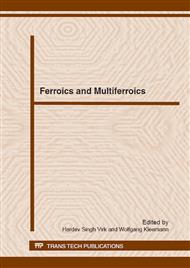p.57
p.95
p.129
p.145
p.169
p.179
p.189
p.209
p.233
Fabrication and Study of Hot Pressed Co0.6Zn0.4Fe2O4-PVDF PbTi0.7Zr0.3O3 and Co0.6Zn0.4Fe2O4-PVDF-BaTi0.7Zr0.3O3 Multiferroic Composite Films
Abstract:
Multiferroic composite films of (i) Co0.6Zn0.4Fe2O4(CZFO)-PbTi0.7Zr0.3O3(PZT)-poly (vinylidene-fluoride)(PVDF) and (ii) Co0.6Zn0.4Fe2O4-BaTi0.7Zr0.3O3(BZT)-PVDF were prepared by hot press method for magneto-dielectric studies. Different multiferroic composite films were named as CPT-1 (CZFO:PZT; 3:1) CPT-2 (CZFO:PZT; 3:2), CPT-3(CZFO:PZT; 3:3), CBT-1 (CZFO:BZT; 3:1), CBT-2 (CZFO:BZT; 3:2) and CBT-3 (CZFO:BZT 3:3). The entire composites were made with 70% ceramic and 30% wt. PVDF polymer. Line scanning by Scanning electron microscope (SEM) and Atomic force microscopy (AFM) images shows a homogeneous distribution of constituents in the composite film. It is observed that the dielectric permittivity (ε´) follows the MaxwellWagner model. Remnant polarization (Pr) and magnetocapacitance (MC) were found to vary with an applied magnetic field at room temperature. The absolute value of the magnetocapacitance (MC) was found higher for CBT-2 (MC ~ 0.79%) than for CBT-3 (MC ~ 0.57%) but lower than for CPT-3 (MC ~ 1.2%). A linear fit of the MC with M2 yields the magnetoelectric quadratic coupling constant |γ| ~ 4.96 × 10-6 for CBT-1, which is around 150 times lower than for CPT-1 (|γ| ~ 7.92 × 10-4).
Info:
Periodical:
Pages:
179-188
Citation:
Online since:
June 2012
Authors:
Price:
Сopyright:
© 2012 Trans Tech Publications Ltd. All Rights Reserved
Share:
Citation:


